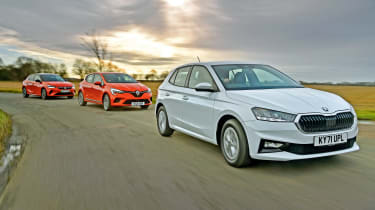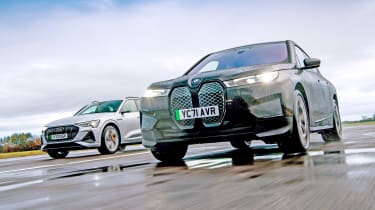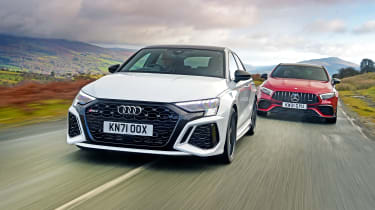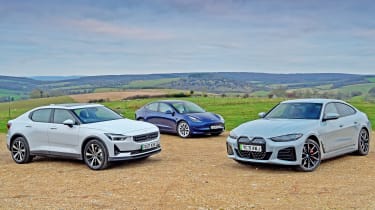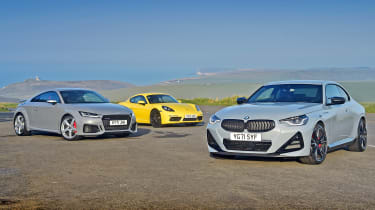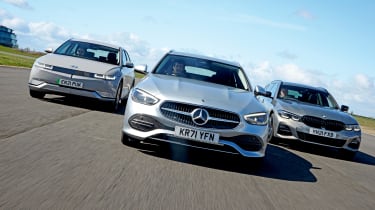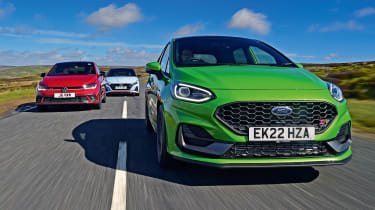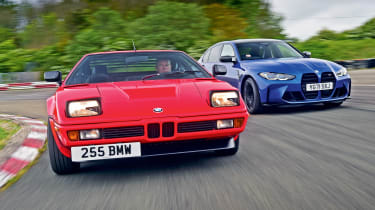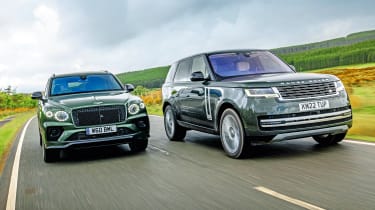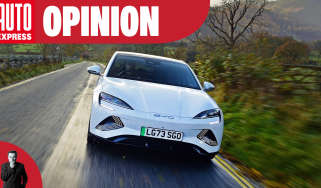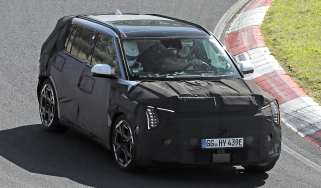Best car group tests 2022: our most memorable head-to-heads
We've pitted many cars against each other over the past year, and these are our favourite battles
No matter how good a new car might be, it’s always going to face stiff competition from a raft of talented rivals - all attempting to catch the eye of potential buyers. So, the most effective way to determine which model is truly the best of the bunch is by pitting them against each other in a head-to-head battle.
2022 saw the arrival of some truly impressive new competitors, particularly in the ever-growing electric car sector. The temptingly-priced MG4 is a key example, and it was up against the more established Kia Niro EV in our October twin-test.
Some long-standing rivalries reappeared, too. The hot hatch challenge was as fiery as ever, with the veteran Ford Fiesta ST and Volkswagen Polo GTI fighting to keep the Hyundai i20 N newbie at bay.
Read on to see our favourite group tests of 2022, and let us know which is your favourite test in the comments section.
January
New Skoda Fabia faces tough first test
2022 kicked off with one of the smallest – yet biggest – tests of the year. Superminis hold a vitally important spot in the UK’s new-car market, and with four of the country’s 10 best selling cars in the 12 months leading up to the contest coming from that very segment, the market for compact, affordable hatchbacks is still clearly in rude health.
Used - available now

2019 BMW
1 Series
55,000 milesAutomaticPetrol1.5L
Cash £14,690
2022 Kia
e-Niro
23,188 milesAutomaticElectric
Cash £14,500
2023 Vauxhall
Corsa
7,145 milesManualPetrol1.2L
Cash £11,567
2023 Tesla
Model 3
35,546 milesAutomaticElectric
Cash £18,300Judging by the standards of the three cars we assembled, that certainly seemed to be the case. The newcomer in the contest was Skoda’s latest Fabia. Now entering its fourth generation, here was a car that had grown a little larger than its predecessor – and become even smarter and better equipped, too.
Such a promising car deserved stiff opposition, so we didn’t go easy on the Czech challenger. The first rival came in the handsome shape of the Renault Clio. It arrived for this contest off the back of two consecutive victories in the Supermini category of our New Car Awards, and it faced up to the Skoda in Iconic trim and featuring a similar three-cylinder turbocharged petrol engine. With the Skoda’s 94bhp output, however, the Skoda held a 5bhp edge on its rival.
The third contestant easily had the other two beaten for outright power, with 134bhp on tap, yet it also boasted zero tailpipe emissions. That’s because our test trio was completed by the pure-electric Vauxhall Corsa-e. We believe that Britain’s best-selling supermini is at its best when paired with the smooth, silent, electric powertrain, but the trouble is that it’s also at its most expensive. The question we wanted to know was whether the time has come for electric superminis to rule the roost.
In the end, the answer was not quite – but that was as much because of the Corsa’s minor shortcomings rather than the electric powertrain as a whole. With a marginally lower price and a slightly longer overall range, the Vauxhall might have achieved more, but in the end, it was its limited interior space and ride comfort that stopped it from really competing.
The battle between the top two in this contest was very close. Compared side by side, the Fabia had the Clio beaten in several areas; it’s slightly more comfortable (although both excel in this regard), there’s even more space in both the back seats and the boot, and the 1.0-litre turbocharged petrol engine was a stronger performer yet slightly more economical, too.
However, the Clio was able to challenge the Fabia extremely closely in every area, and its killer blow was dealt by its bargain price. When we measured up the monthly PCP payments, the Clio’s equivalent trim levels weighted in at £15-£20 per month less on an identical three-year PCP deal with a £2,000 deposit. Better still, the Clio was available on a two-year, interest-free PCP (as it still is), making it even more of a bargain.
BMW comes out on top in battle of premium EVs
This face-off between two ultra-luxurious EVs proved just how quickly the market is moving forward. On our first encounter with the Audi e-tron in 2018, it proved to be a fabulously comfortable, relaxing EV with fantastic tech.
Despite this, the BMW had it comfortably beaten. The iX is even more silent and relaxing, yet sharper to drive. The BMW is much more efficient, too, while its iDrive tech is among the best, and its cabin feels truly special, too. It’s an incredible, if pricey, achievement.
February
Hyper-hatches in head-to-head battle
There’s always been a power race among the German brands, and nowhere is that more clear than in the hot hatch segment. In fact, with the latest Audi RS 3 and Mercedes-AMG A45 S, it’s a wonder whether they are now so extreme (and expensive) that they’ve established a class of their own.
The on-paper stats are mind boggling – just 20 years ago, they would more than likely be considered supercar numbers. The Audi is unique in this segment thanks to its turbocharged five-cylinder engine. It’s not short of power either, with 394bhp and 500Nm – the latter available from 2,250rpm right the way through to 5,600rpm. However, the Mercedes is even more potent; AMG’s boffins have squeezed out a staggering 415bhp from an even smaller 2.0-litre four-cylinder turbo.
To find out how these hyper-hatches measured up against each other, we took them to stunning – and predictably, for winter, sodden – South Wales.
Both the roads and the climate only helped to show this pair in their absolute element. Along the twisty, undulating tarmac and with limited traction on the slippery surfaces, there were few other cars at any price that could have kept up, and there was very little to separate the pair when it came to the maximum limits of grip.
Each offered stunning acceleration too, with 0-62mph times of 3.8 and 3.9 seconds for the Audi and the Mercedes respectively. So in purely objective terms, then, this pair was very evenly matched. And we couldn’t even really separate them on the more sensible stuff like cabin space or fuel consumption, either.
However, for cars that have such a similar brief, the pair have drastically different characters. Character is certainly a word that soon springs to mind when you explore the range of the Audi’s fabulous engine. The five-cylinder soundtrack gives a rich, full-bodied sound that couldn’t be mistaken for anything else. It sounds great at gentle speeds too, so driving it always feels like a special occasion.
Given that it has a four-cylinder unit, the Mercedes already sets itself up for a different personality. But although the engine note sounds suitably angry, it’s the chassis which really sets it apart.
To us, a hot hatchback should feel exciting, sharp and just a little bit unhinged – and in those crucial areas, the A45 holds an edge over its rival. Turn into a corner, and the Mercedes’s chassis feels pointy and agile in manner more befitting of a thoroughbred performance car than a five-door hatchback. Yes, you have to take it by the scruff of the neck, but do that and you’ll emerge from every enthusiastic drive completely exhilarated.
By contrast, the Audi is accomplished to the point where it lacks some of the AMG’s feel and poise. Of course, it’s staggeringly quick, but after many drives, you’ll feel like it was the car doing the work, rather than you.
BMW i4 clashes with Polestar and Tesla rivals
February saw us match up three of the best long-rangers of the EV segment, with the all-new BMW i4 facing off against the Polestar 2 and Tesla Model 3.
In the end, the result stood at 4, 3, 2. The BMW took the win thanks to the brilliant driving experience, while the Tesla’s performance, efficiency and superb charging network helped it into a very close second. The Polestar propped up the standings, not quite able to compete with the other two for range or in-car tech.
March
New Lexus NX beats Audi Q5
Toyota and its luxury sister brand Lexus are both undergoing something of a renaissance at the moment – and nowhere was this demonstrated more emphatically than when the brand-new Lexus NX 450h+ took a shock twin-test win against one of the consistent leaders of the posh SUV segment, the Audi Q5.
On our first chance to get behind the wheel of the NX, we struggled to bring to mind another car that had exhibited such a vast improvement over its predecessor.
Of course, Lexus has always excelled in some areas – namely refinement, build quality and reliability – but the new model built on its maker’s traditional strengths to deliver a genuinely complete package.
Take the infotainment system, for example. In recent times, this had become renowned as the single greatest weakness of a Lexus product, but we found that the 2022 NX had ditched the bizarre trackpad and clunky user interface for a large touchscreen, that loaded quickly, looked great and was simple to use.
Even the Q5, which has one of the slickest systems itself, couldn’t compete in this area. Nor could it match the Lexus in a few other key areas too. Not only had Lexus delivered a car that was relaxing to drive, but it was fast and capable, too. The plug-in hybrid powertrain’s 305bhp comes predominantly from its two electric motors, giving instant performance that even the 295bhp Audi could struggle to match – whether in full-power or pure-EV mode.
As far as most buyers are concerned, the main benefits of a plug-in hybrid come in the shape of lower fuel and tax costs. And when we looked at these two models, the Lexus emerged as the better car in both respects.
With a WLTP-rated range of 43 miles, the NX could also travel six miles further than the Q5 on a single charge. But even with its battery depleted, the Japanese victor proved to be as frugal as the brand’s conventional hybrids, achieving a fantastic 48.9mpg in our hands – no less than 14.2mpg better than the Audi could manage. Plus, the Lexus felt more sprightly when driving in pure-electric mode.
There’s still plenty to like about the Audi – its comfort, for a start – but we saw this as a huge moment for Lexus. The NX proved to be the first car from the company in a long time that you could buy not just because it was more reliable than the German alternatives – or simply because you wanted to be different. This was a Lexus you could buy because, quite simply, it was the best car in its class.
April
New BMW coupé lines up against Porsche and Audi rivals
Driver’s cars have always been instrumental in forming BMW’s identity. So when a new, sporty model arrives from the brand, we’ll take notice. Back in April we had the chance to pit the new 2 Series Coupé, in its most potent form to date, the M240i, against rivals from Audi and Porsche.
There are fascinating contrasts between the models – for a start, their engines. The BMW has a 3.0-litre turbocharged in-line six, the Audi TT gets a 2.5-litre five-cylinder, and the Porsche 718 Cayman has a 2.0-litre flat four. Of those, the TT is the most potent, with a thumping 395bhp on tap. However, the Cayman has lower weight on its side, and it sends its drive to the rear wheels only, while the BMW and Audi both offer four-wheel drive traction.
Despite that weight penalty, the M240i was exceptionally capable. Its chassis was very composed, while traction and grip were phenomenal, ensuring strong cross-country pace.
The Audi was even quicker, but it all seemed a little clinical. There wasn’t much adjustment to the chassis, and that combined with lifeless steering to leave it feeling short on character. That’s not a criticism that could be levelled at the TT’s wonderful engine, though; the five-cylinder unit sounded brilliant and made the Audi incredibly rapid.
That left the Porsche. Yes, it was slowest in a straight line, and yes, the engine sounded dull, but for a keen driver, the chassis would make up for that completely. Next to the other two, it felt alive through the corners, transmitting endless feedback through the controls, and being a size and weight that felt perfect for British B-roads.
In the end, though, it was a victory for the new BMW. It was more involving to drive than the Audi, and faster than the Porsche, yet was much more practical than either.
We find the top choice for company car drivers
Which is the best company car: diesel, plug-in hybrid or electric? We found out by lining up the best of each: the Mercedes C220d, BMW 330e PHEV, and Hyundai Ioniq 5. The Ioniq 5 took the win, offering a huge amount of performance, space and refinement. The BMW was great to drive, and had a lower Benefit-in-Kind cost than the Mercedes. However, the C220d’s incredible 70.5mpg on test proved that there’s still life in diesel power yet.
May
Hyundai i20 N claims Fiesta ST’s hot-hatch crown
The Ford Fiesta ST has been the king of the hot hatches for some time, but that all changed in May, when the Hyundai i20N wrestled the crown out of its hands. The Ford remained thrilling to drive, and subtle updates gave it a new face and more kit, but the i20 felt just as hardcore while being even better value for money. As with the standard i20, the N is a little more practical than the Fiesta, too. Third place went to the VW Polo GTI; it was very quick, but felt a little aloof in this company.
Birthday bash marks 50 years of M cars
This year marked the 50th anniversary of the first BMW M car entering production, so Steve Sutcliffe took a very special look back at one of the most evocative letters in the performance car alphabet, by assembling some of the M Division’s greatest hits.
The venue was Llandow circuit in Wales, where Steve had the opportunity to explore the capabilities of these cars side by side. He started with the M1. This was the first full-production car to wear the M badge, and one which was a happy accident after motorsport plans for the mid-engined coupé were shelved.
On our recent encounter with the M1, it became very clear that many of the defining characteristics that would go on to be hallmarks of all the best M cars – beautiful control weights, a spine-tingling engine and sharp handling – were established right here.
What became evident as Steve moved from the M1 to the M635i and back to the E30 M3, was that there were different characteristics within the brand. Some cars were true race cars for the road, while others had that feel, but delivered in a more comfortable, sophisticated package.
Other more modern highlights followed; from Steve reacquainting himself with cars that he tested back in the day, such as the Z3 M Coupé, to cars he liked so much that he actually bought, such as the V8-powered E39 M5.
The brand explored technology throughout its history, with the noughties showing early, rather clunky, forays into automated manual paddle-shift transmissions in the E46 M3 CSL and E60 M5. Those cars, ironically, linked the gearboxes to two of the finest engines that M ever built: the M3’s 3.2-litre, 333bhp straight six and the M5’s 500bhp, 5.0-litre V10, a configuration chosen to imply ties with BMW’S Formula One involvement at the time.
From there, the technology grew, along with both the power outputs and the weights. The 1M was among those to buck that trend, with its compact size, rabid personality and muscular looks, and the E92 M3 GTS, the stripped-out coupé blessed with a huge dollop of V8 power and limitless potential for slides. Even in 2009 it cost £117,000, which only goes to highlight the fact that M threw all of its motorsport-derived know-how at it.
We brought the test to its conclusion via the exceedingly rapid M5 30 Jahre (itself a celebration of 30 years of the M5) and the current G80 M3. In many ways, we discovered the latter car encapsulated many of the best qualities of its predecessors, rounding them all up into a package that’s not only exciting but also easy to live with every day.
June
SUVs battle it out to find which is best of British
We put the best of British up against each other in issue 1,734, with the all-new Range Rover going head to head with the magnificent Bentley Bentayga.
Land Rover was on to a winner with its luxury SUV. Both feel opulent, but while the Bentayga focused more on the driver, we rated the Range Rover’s ability to make all of its occupants feel like royalty. Its tech was slicker and, not that it matters too much at this price point, it was also less expensive.


